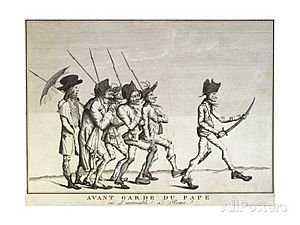Battle of Faenza facts for kids
Quick facts for kids Battle of Faenza |
|||||||
|---|---|---|---|---|---|---|---|
| Part of the War of the First Coalition of the French Revolutionary Wars | |||||||
 A satirical depiction of the Papal Army before the Battle of Faenza. |
|||||||
|
|||||||
| Belligerents | |||||||
| Commanders and leaders | |||||||
| Strength | |||||||
| 9,000 | 7,000 | ||||||
| Casualties and losses | |||||||
| 100 killed or wounded | 800 killed or wounded 1,200 captured 14 artillery guns captured |
||||||
The Battle of Faenza, also known as the Battle of Castel Bolognese, happened on February 3, 1797. It was a fight between the French Army and the Papal Army. About 7,000 soldiers from the Papal Army, led by Michelangelo Alessandro Colli-Marchi, faced 9,000 French soldiers. The French troops were commanded by Claude Victor-Perrin.
The battle took place near the towns of Castel Bolognese and Faenza in what was then the Papal States. These towns were close to the Senio River. The experienced French soldiers quickly defeated the Papal army. The French suffered far fewer losses than their opponents. This battle was part of the War of the First Coalition, which was a bigger conflict within the French Revolutionary Wars.
Why the Battle Happened
Before this battle, a long fight called the Siege of Mantua had just ended. On February 2, 1797, the Austrian army, led by Dagobert Sigismund von Würmser, surrendered to the French. The French army was commanded by General Napoleon Bonaparte. After this big victory, Napoleon decided to move his army into Romagna. This area was part of the Papal States, which were lands ruled by the Pope.
The Papal army was led by an Austrian officer named Michelangelo Alessandro Colli-Marchi. He was an experienced soldier who had fought in earlier wars. Colli had even faced Napoleon's army before. However, he was getting old and sometimes had to be carried because of old injuries.
The French army was very skilled and confident after many wins in Italy. The Papal army was different. It had some regular soldiers, but many were local militia groups or cavalry units. These were called up only when needed. Their training was old-fashioned, focusing on parades more than real fighting. This meant the Papal army was not ready to face the strong and motivated French forces. They were better suited for keeping order within their own lands than fighting a major war.
The Battle Begins
On February 3, the French commander, Victor, found Colli's Papal troops. They were positioned along the Senio River near Castel Bolognese and Faenza. The Papal army's cannons started firing first, causing some injuries to the advancing French soldiers.
However, the French army quickly launched an attack across the Senio River. They easily broke through the Papal infantry (foot soldiers) and cavalry (horse soldiers). The French captured 14 of the Papal army's cannons. The battle was over very quickly. Victor's soldiers lost only about 100 men. In contrast, the Papal troops suffered about 800 casualties (killed or wounded). The French also captured 1,200 Papal soldiers, along with their cannons and other supplies. A French general named Jean Lannes led a special group of elite soldiers called grenadiers during this battle.
What Happened Next
After this quick victory, the French army continued to advance. The port city of Ancona, also in the Papal States, surrendered to Victor's forces on February 9. The Papal soldiers there, about 1,200 men, and 120 cannons were captured without any fighting.
The Pope, Pope Pius VI, was then forced to sign a peace agreement called the Treaty of Tolentino on February 19. This treaty made the Papal States give up valuable artworks, treasures, and some of their land to France. They also had to pay France 30 million francs, which was a huge amount of money at the time.
See also
- War of the First Coalition
- Michelangelo Alessandro Colli-Marchi

